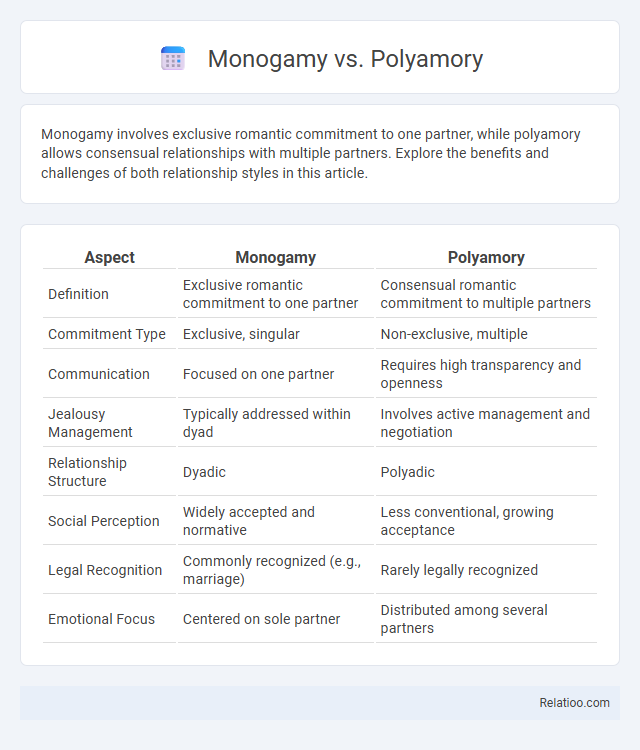Monogamy involves exclusive romantic commitment to one partner, while polyamory allows consensual relationships with multiple partners. Explore the benefits and challenges of both relationship styles in this article.
Table of Comparison
| Aspect | Monogamy | Polyamory |
|---|---|---|
| Definition | Exclusive romantic commitment to one partner | Consensual romantic commitment to multiple partners |
| Commitment Type | Exclusive, singular | Non-exclusive, multiple |
| Communication | Focused on one partner | Requires high transparency and openness |
| Jealousy Management | Typically addressed within dyad | Involves active management and negotiation |
| Relationship Structure | Dyadic | Polyadic |
| Social Perception | Widely accepted and normative | Less conventional, growing acceptance |
| Legal Recognition | Commonly recognized (e.g., marriage) | Rarely legally recognized |
| Emotional Focus | Centered on sole partner | Distributed among several partners |
Understanding Monogamy: Definition and Origins
Monogamy refers to a relationship structure where an individual commits to a single partner at a time, rooted in social, cultural, and biological origins dating back thousands of years. Understanding monogamy involves recognizing its emphasis on emotional and sexual exclusivity, promoting deep bonding and stability. Your awareness of monogamy's definition helps clarify how it contrasts with polyamory and other non-exclusive arrangements.
Exploring Polyamory: Meaning and Types
Polyamory refers to engaging in multiple consensual romantic relationships simultaneously, emphasizing transparency, communication, and ethical agreements among all parties involved. Common types of polyamory include hierarchical structures, where primary and secondary relationships are defined, and non-hierarchical models, which treat all partners with equal importance. This approach contrasts with monogamy, which involves exclusive romantic commitment to one person, and exclusivity, which focuses strictly on sexual or emotional fidelity within a relationship.
Cultural Perspectives on Relationship Structures
Cultural perspectives on monogamy, polyamory, and exclusivity vary widely, shaping societal norms and individual relationship choices. Many Western cultures traditionally prioritize monogamy and exclusivity as standard relationship frameworks, often linked to legal and religious institutions. You may find that more diverse or indigenous communities embrace polyamory or non-exclusive structures, reflecting values of interconnectedness, flexibility, and communal support in their social bonds.
Emotional Benefits of Monogamy
Monogamy offers deep emotional benefits such as enhanced trust, security, and intimate bonding due to a singular focus on one partner, fostering profound connection and stability. The consistent emotional support within monogamous relationships reduces anxiety and increases overall relationship satisfaction. Studies show monogamous couples often experience greater emotional resilience and stronger commitment compared to polyamorous or non-exclusive relationships.
Challenges and Myths Surrounding Polyamory
Polyamory presents unique challenges such as managing multiple emotional connections, navigating jealousy, and maintaining clear communication with all partners. Myths suggesting polyamory is inherently unstable or a phase undermine the genuine commitment and complex dynamics involved. Understanding these distinctions helps you make informed choices about relationship structures without falling prey to common misconceptions.
Communication and Boundaries in Both Models
Effective communication and clearly defined boundaries are fundamental to both monogamy and polyamory, ensuring trust and respect within relationships. In monogamous partnerships, boundaries often focus on exclusivity and fidelity, while polyamorous dynamics require negotiating multiple concurrent relationships with distinct terms. Transparent dialogue about needs, limits, and expectations prevents misunderstandings and supports emotional well-being across both models.
Jealousy and Trust: Navigating Emotions
Jealousy and trust play central roles in navigating relationships defined by monogamy, polyamory, and exclusivity. In monogamous and exclusive partnerships, trust often hinges on the assurance of emotional and physical fidelity, with jealousy emerging from perceived threats to exclusivity. Polyamorous relationships require establishing clear communication and boundaries to build trust, as jealousy is managed through openness and mutual respect for multiple emotional connections.
Social Acceptance and Stigma
Monogamy remains the most socially accepted relationship model globally, often viewed as the normative standard, which reduces stigma for those practicing exclusivity. Polyamory faces greater social stigma due to misconceptions about commitment and morality, although acceptance is growing in progressive communities and among younger generations. Exclusivity in relationships is closely tied to monogamy but can exist within various relational frameworks, with its acceptance largely dependent on cultural and societal norms.
Legal and Ethical Considerations
Monogamy, polyamory, and exclusivity each present distinct legal and ethical considerations that impact relationship dynamics and individual rights. Legal systems often recognize monogamous marriages exclusively, creating challenges for polyamorous arrangements regarding marriage benefits, custody, and healthcare decision-making. Understanding these implications helps you navigate the ethical responsibilities of honesty, consent, and fairness while respecting the boundaries set by law.
Choosing What Works: Personal Fulfillment and Relationship Goals
Choosing between monogamy, polyamory, or exclusivity hinges on aligning your relationship style with personal fulfillment and long-term goals. Understanding your emotional needs, communication preferences, and boundaries ensures healthier connections and mutual respect with partners. Prioritizing clarity and honesty supports sustainable relationships tailored to your unique desires and values.

Infographic: Monogamy vs Polyamory
 relatioo.com
relatioo.com